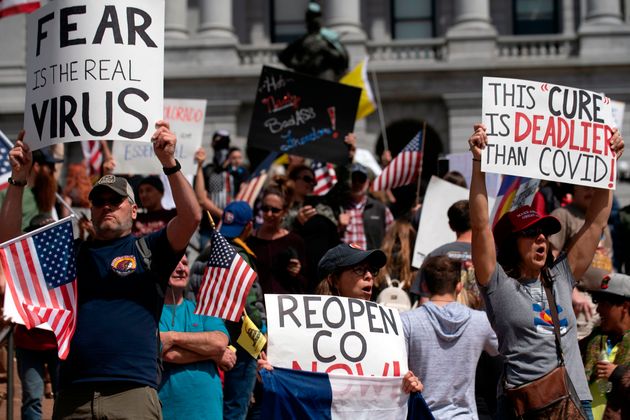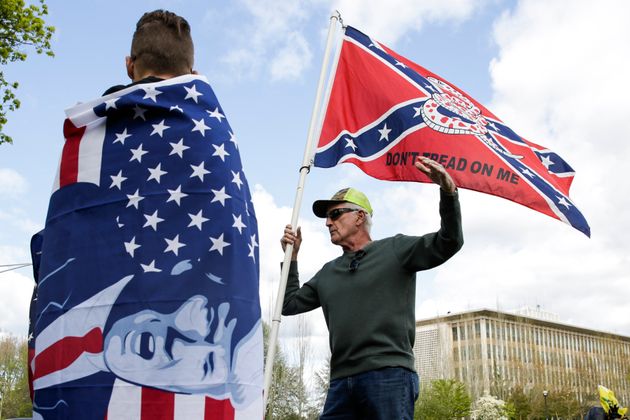President Donald Trump on Sunday defended right-wing protesters he appeared to previously encourage to rally across the country for states to reopen the economy despite governments and health experts deeming it not safe enough to do so.
Since last week, thousands of protesters in more than a dozen states have taken to the streets to demand stay-at-home orders be lifted, even though public health officials have warned that lifting restrictions too early could lead to a spike in cases.
The protesters have been mostly right-wing followers, anti-vaccination advocates and gun rights activists who in some photos can be seen standing close together without masks or gloves, in defiance of the social distancing guidelines meant to slow the spread of the virus and flatten the curve.
At Sunday’s White House coronavirus briefing ― an event that the president has mostly used to campaign and push misinformation ― Trump was asked what his advice would be to protesters who want to lift states’ stay-at-home orders.
“You’re allowed to protest. … I watched a protest and they were all six feet apart, I mean it was a very orderly group of people,” Trump said, despite photo evidence of many of these rallies showing otherwise. “But you know, some governors have gone too far. Some of the things that happened are uh, maybe not so appropriate, and I think in the end it’s not gonna matter because we’re starting to open up our states.
“I see protesters for all sorts of things, and I’m with everybody,” he said.
In a series of tweets on Friday, Trump called to “LIBERATE” Minnesota, Michigan and Virginia ― three swing states with Democratic governors ― in an echo of the protesters’ demands. A day earlier, the president outlined guidelines in three phases for reopening the economy in some areas over a period of several weeks.
Asked on Sunday if he was concerned that his tweets helped incite violence against the governors ― some of whom are receiving death threats from protesters ― Trump immediately denied it.
“I’ve seen the people, I’ve seen the interviews of people. These are great people,” Trump said. “Look they want to get ― they call cabin fever, you’ve heard the term ― they’ve got cabin fever. They wanna get back. They want their life back. Their life was taken away from them. And you know, they learned a lot during this period. They learned to do things differently than they have in the past. And you know, they’ll do it hopefully until the virus has passed.
“I think these people are ― I’ve never seen so many American flags,” he continued. “I’m seeing the same thing you’re seeing.”
When the reporter who asked the question pointed out there have also been Nazi flags flown at these rallies, Trump repeated: “No, no.”
“They’re who? Well, that I totally would say, no way,” the president said. “But I’ve seen ― I didn’t see that. I see all ― of course, I’m sure the news plays that up. I’ve seen American flags all over the place. I have never seen so many American flags at a rally as I have at these rallies. These people love our country and they wanna get back to work.”


Trump’s enabling response to the protesters echoed his handling of the 2017 Unite the Right rally in Charlottesville, Virginia ― where neo-Nazis protested against taking down Confederate monuments in a violent white supremacist rally that left one counter-protester dead and dozens more wounded.
After the Charlottesville violence, Trump refused to single out the activity of white supremacists and instead falsely claimed that there was “bigotry and violence on many sides.” He then doubled down on his comments, equating Nazis with people who are against fascism by saying there were “very fine people on both sides” at the rally.
In the United States, at least 40,666 people have died as of Sunday evening from COVID-19, the disease caused by the virus, with at least 758,720 confirmed cases, according to data compiled by Johns Hopkins University. The death toll in the U.S. is almost twice as high as Spain’s, the country with the second-most virus-related deaths in the world.
Stay home.
- Stay up to date with our live blog as we cover the COVID-19 pandemic
- What happens if we end social distancing too soon?
- What you need to know about face masks right now
- How long are asymptomatic carriers contagious?
- Lost your job due to coronavirus? Here’s what you need to know.
- Everything you need to know about coronavirus and grief
- The HuffPost guide to working from home
- What coronavirus questions are on your mind right now? We want to help you find answers.
-
Everyone deserves accurate information about COVID-19. Support journalism without a paywall — and keep it free for everyone — by becoming a HuffPost member today.